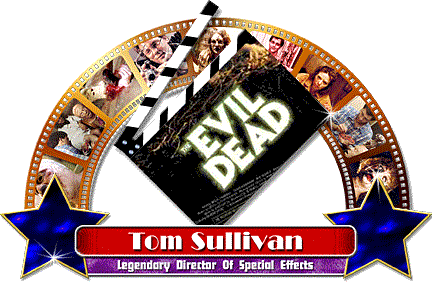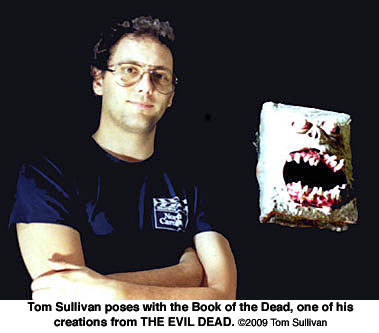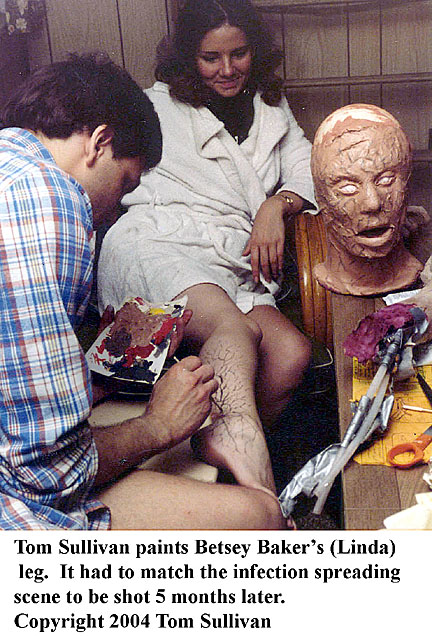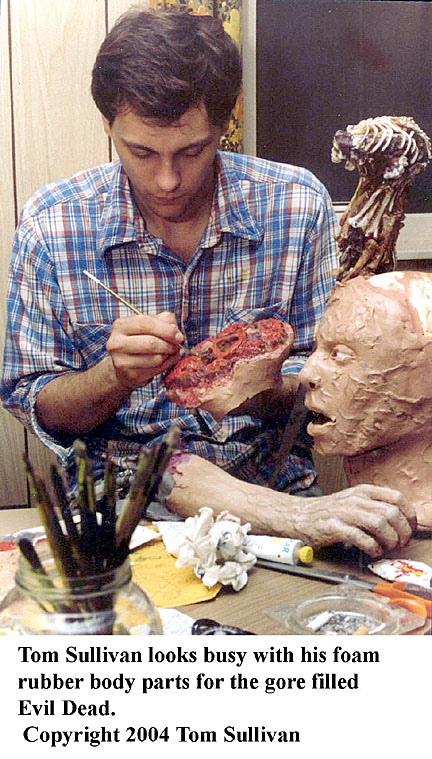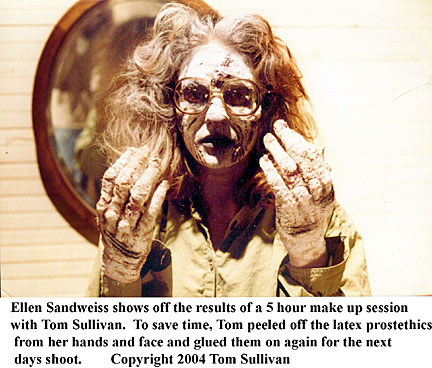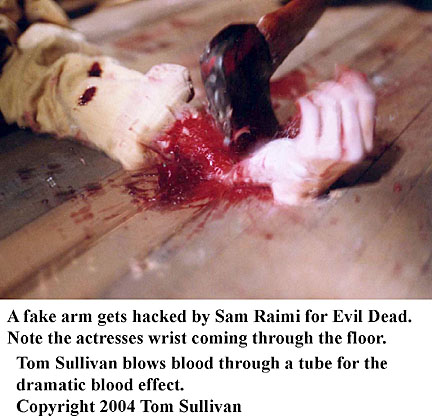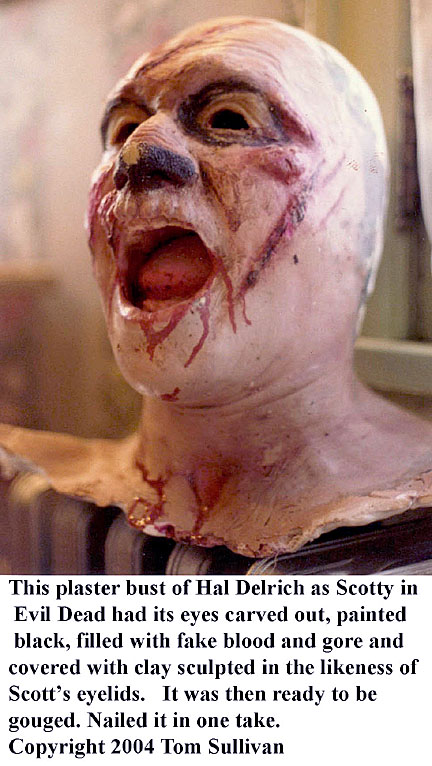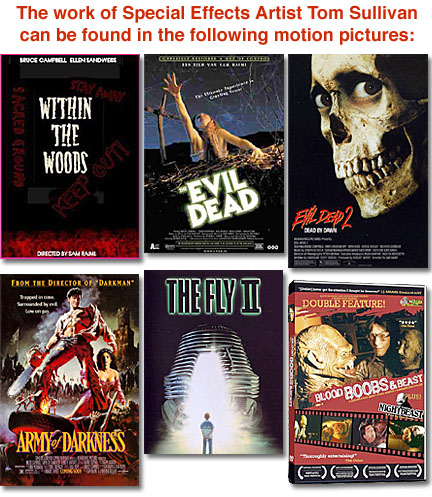Search
EVIL DEAD’s Legendary Director of Special Effects Tom Sullivan
Interview ©2004/2009 by Robert Long II
Robert: Tom, thank you so much for granting this interview. My first question is how long have you been involved with special effects makeup?
Tom: About 2 years out of High School (1973-74) I started to make face castings and rubber slush mold appliances. I started with my meager copy of a John Chamber’s Planet of the Apes Chimp.
For one Halloween I had a bunch of Make up kits with a variety of glue on appliances such as Gorilla, Demon, Witch, and Pinhead. It had Spirit Gum and Remover and Rubber Mask Grease Paint included. So a year later when I met Sam Raimi and Rob Tapert I had some of the basic skills they were going to need.
Robert: Who were your inspirations when getting interested in the field?
Tom: Lon Chaney, Dick Smith, John Chambers, William Tuttle, Rick Baker, Rob Bottin. It was hard not to be impressed by the masters. As I was learning abut this art the 1970s were an exciting time for Make-up technology. New Foam Rubbers, Don Dohler’s Cinemagic brilliant special effects magazine was a revelation, new materials were available, Cables, Bladders, Animatronix, were being developed and used in innovative projects.
Robert: Did you often experiment doing character makeup on yourself?
Tom: A little but mostly I experimented on friends. They had a blast wearing the Ape makeups.
Robert: How did you get your experience? Are you self-taught, or did you get training?
Tom: I am self-taught. I learned from Corson’s Stage Makeup Book and the issues of Don Dohler’s Cinemagic. I found every book I could on the subject, both historical and instructive.
Robert: Is this your full time occupation, or do you have a 9 to 5 and freelance as a makeup artist?
Tom: I have not done Make Up FX since some Commercial, Educational and Industrial film work in the early 1990s. I taught myself a broad range of skills so I could be an “Uber” Director.
I wanted to create the graphics and writing preparation myself to clearly transmit my vision to the various departments. Evil Dead only required my Make Up, Art and other Special Effects skills.
I am an Illustrator and Writer these days with a goal of Producing and Directing my scripts. I also do a number of Guest appearances at Horror Conventions each year, and produce replicas of my Evil Dead props and publish archival quality prints of my Evil Dead art and H.P. Lovecraft illustrations.
Robert: Tom, how do you go about budgeting for makeup and makeup effects in a low-budget independent movie?
Tom: Read the Script and list each effect and makeup need.
Design your approach to each need and list all materials and tools required.
Collect all the material and tool catalogs you can and after evaluating the amounts of supplies required, price and order what you need.
Have a budget for the unexpected. Plan for retakes and some research. You may not get those luxuries but its up to you to get the job done.
Robert: Does the Film Company come to you with their budget and you try to work within it?
Tom: Typically that is the process. Of course a blank check is always preferred It’s not usual to be handed a script to breakdown for the FX artist to come up with a bid. Try to be as accurate and have a 15% overage for complete screw-ups. Don’t set your self up for disaster.
Robert: Do you look at the script and tell them what you think it is going to cost? Do you just do it for a fixed rate?
Tom: Yes, One would lock yourself into a budget and be expected to deliver. Of course a wise Producer would have some backup funds for emergencies.
Robert: Are you also trained to do regular glamour makeup as well? If so, is it a drastically different mindset that you have to have to keep that sort of style distinct from the effects makeup?
Tom: I have no skill at all at glamour make up. On Evil Dead I let the Ladies know that I was leaving that up to them. They did a great job. Lots of practice I guess. It sure helped with the schedule I had. This make up work sure has long hours.
Robert: With low-budget features being the nature that they are, have you had to wear various different “hats” other than makeup artist on the productions that you have worked on? What were they?
Tom: I was fortunate to have a variety of effects and props and Art Direction (uncredited) contributions for Evil Dead. I created (and illustrated) the Book of the Dead and Kandarian Dagger, Full Sized Clay Animation Puppets, the Deadite masks and makeups. I created the false body parts for cutting, gun blasts, axings and bitings. I mixed the blood recipes and blew it through plastic tubes. I wore the demon gloves that burst out of the Deadites at the finale. I along with Bart Pierce animated the stop motion finale over a three month period. I also did storyboards and character designs and a script cover. On The Fly Part 2 I was brought in as a maquette concept designer with about 10 other artists and was able to stay on and sculpt and make molds and some suit fabrication.
Robert: How well should a person know the human inner anatomy? The reason I bring this up is for when making up body parts for horror movies or battle scenes or what have you. Should a person study the inner workings (organ and bone structure) to come up with more realistic appliances and parts?
Tom: Yes, knowledge of anatomy is essential. Keep a morgue. Dissect your neighbors. With a little luck you won’t need to fake anything for your film. Actually on Evil Dead I had no interest in making any effect look “real”. I was not out to assault the audience. I was trying to make it fun. Like a neighborhood haunted house. I wanted the audience to know it was a fake and an entertaining, over the top effort. However a detailed knowledge of anatomy is important to any artist. Know your subject.
Robert: Tom, several features have used actual animal organs to represent human organs in movies. Have you ever had to handle this? If so, what were the organs? Are there any health risks involved?
Tom: No, I have not used real organs. A rack of ribs from a Butcher’s market was used for a Deadites shoulder’s shotgun hit in Evil Dead. It is so unsanitary even under the best conditions I would not recommend it at all. Listen to the Day of the Dead commentary for further appetizing details.
Robert: What type of characters and/or creatures have you been asked to create with your skills?
Tom: I designed the Deadites for the original Evil Dead. The original concept of mine was to incorporate ancient Sumerian/Babylonian supernatural creatures. This culture was mentioned in the script. I sculpted masks (over the actor’s face casts) of a Dog, a Hawk, and a Snake to represent the demons possessing the College students. I showed them to Sam Raimi and he said it was starting to look like “Planet of the Apes”. We discussed the demons being grotesque Caricatures of the characters being possessed.
I mentioned Dick Smith’s Exorcist work and Sam agreed and so I was borrowing from Dick Smith rather than John Chambers. The Dog mask is the only hold over from the early mask designs. The Scotty character played by Hal Delrich deserts his best friend Ash to deal with the carnage and to save himself. So Scotty became a Dog.
Robert: Were some easier to do than others or do they all present a challenge in their own way?
Tom: All the makeups took about the same time to do. About 4 to 5 hours. Scotty’s and Linda’s extreme makeup’s were prosthetics, Cheryl’s and Shelly’s makeup’s were built up. Other than some hair spray or powder for the most part the makeups were just facial.
Robert: What was the most elaborate?
Tom: Cheryl’s character, played by Ellen Sandweiss was the most elaborate as it had the most changes through her story. Her hands also required some distressing. I treated her makeup as though she had a horrible disease. The first appearance she is just painted. She looks dead. From there she changes in spurts. Gets real ugly fast.
Robert: What was the strangest makeup effect you have ever had to do?
Tom: I made a talking chin for a commercial. It was supposed to be a dinky character in a L.A. hot tub sipping on a soda. It was an actor upside down, chin up with his head submerged in the water with some little eyes and nose and ears and a hairpiece and hat on his chin. The actor’s face was covered with swimming trunks. Looked weird but funny when he talked.
Robert: What was the most difficult makeup job you have had to do, and what were the reasons that it was difficult?
Tom: Evil Dead 2: Dead by Dawn was a year in Hell. On Evil Dead Sam had left me alone to work my magic thanks to the lack of preproduction he offered. On ED 2 Sam’s directorial style had changed so he was micromanaging every detail. This lead to reshoots, delays and in one profoundly disappointing case the elimination of big Stop Motion sequence at the finale.
Robert: What has been the most personally rewarding makeup job you have done, and why was it so rewarding?
Tom: Easily the Cheryl makeup has been thanks to Ellen Sandweiss’s memorable performance and Mike Ditz, Evil Dead Photographer for taking his definitive portrait of Cheryl under the trap door. That is probably the image I will be remembered for. Thanks Mike!
Robert: While it is true that there are professional makeup cases available, I know that in many circles a good fishing tackle box will work in a pinch. What type of makeup case did you use?
Tom: I always threw my stuff into a cardboard box. I put a large piece of cardboard on the bottom so the little stuff wouldn’t fall out. A fishing tackle box is a good idea.
Robert: What do you believe should be in a well-stocked makeup kit?
Tom: I would have everything that’s in a good makeup supply catalog so you are ready for anything. Have mold making and casting supplies for any project that might come up.
Robert: Tom, did you use commercial fake blood, or do you have your favorite homemade mixture? If homemade, what are the ingredients, is it toxic or safe, and does it stain? Lastly, does it dry to look like dried blood?
Tom: For Evil dead I used Sam Raimi’s Blood recipe:
1 qt. Corn syrup
2 oz. Red Food Coloring
1 drop Blue Food Coloring
1/2 cup water mixed with instant coffee mixed into a paste
Mix the serum thoroughly, serve at room temperature.
It is safe, edible (not that you’d want to) but will stain everything it touches. It great for puking your bloody guts out. It has put me off coffee since blowing blood through plastic tubes for 7 months on Evil Dead.
If you are not putting it in your actors mouths but getting it on clothing and skin and need to wash it out you may try adding some clear liquid dishwashing soap to the Blood to aid in cleanup.
It does not look like dried blood but it will stay fresh looking for at least a year. Bruce Campbell had to wear a bloody “Ash” shirt for some additional photography a year after the Tennessee shoot and the blood looked like it just flowed out a juggler.
Robert: Crepe hair is considered the standard for creating hair appliances. Is there any other type of hair you prefer to use? How does one go about cutting and coloring it to get the desired effect?
Tom: I like crepe hair, however my hair skills are weak so I’ll leave that to the experts.
Robert: How did you keep track of how a person’s makeup looked from day to day? Say they have a cut or black eye or what have you and it needs to look the same from scene to scene.
Tom: I had some front and profile drawings of the scratches, scars and bruises of the actors and would modify those. Fortunately in Evil Dead the noticeable continuity errors, especially with the make up show my mistakes and that adds charm to the Evil Dead experience.
Robert: Are you able to sketch out what you feel a particular character’s look and makeup should look like? Do you feel this is a valuable skill in showing the producer and director of the project what you have in mind?
Tom: Yes absolutely. A series of drawings of the make-ups and Maquettes are preferred. The more you concepts you can convey to the Director the clearer a picture you will have of what the Director wants. Usually today’s film make ups and suits have complex ideas behind them and a single creature can have several metamorphosis and states of expression. Decisions have to be made and your art moves that process along. I recommend your concept work blows the Director and Producer away and they’ll hopefully leave you alone.
Robert: Scolera contacts have been around for awhile, and are usually used to completely cover an actor’s eyes for a completely different, dramatic effect. Have these gotten anymore comfortable to wear over the years, or does the makeup artist still need to get them out of the actor’s eyes after fifteen minutes? What are the dangers of these sort of contact lenses?
Tom: Evil Dead was back in the Stone Age days of contact lenses. It has changed for the better today. On the set the lenses could only be in the eyes for fifteen minutes. By day three they were out of cleaning solution and used coffee to rinses them off before use. I only approved the “white out” look for the deadite make ups and never put in a lens in an Actors eyes. Ick!
Robert: What would be your advice to low-budget filmmakers who need to use specialized lenses?
Tom: Today everybody sells custom contact lenses. Custom Lenses have replaced Plastic Food Storage Containers as a sales novelty. So the good news is you have a lot of alternatives and price ranges and they are safer and more comfortable. Happy hunting!
Robert: Casting body parts: do you do slush molding or foam rubber for prosthetic makeup pieces?
Tom: That would depend on the use of that specific piece. Normally for limb reproduction I would not slush mold as the foam rubber will make a good surface for finish and painting.
On Within the Woods, a Sam Raimi horror short I did a slush mold and filled it with a foam rubber and baked it. Bruce Campbell was to have his wrist almost severed by a knife and he was to rip the useless hand off the stump.
The latex rubber skin was too tough to pull apart so Bruce bit through the rubber and made movie history. That improvisation was repeated in Evil Dead when Shelly bites her hand off. Shelly’s arm in Evil Dead was foam rubber only. It had a rubber tube it in for blood to be blown through.
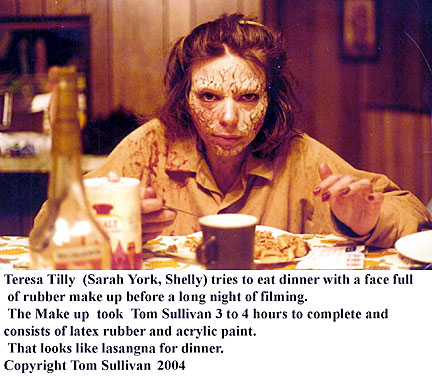
Robert: Tom, have you ever run into people that are claustrophobic and give you a difficult time in casting them for makeup?
Tom: Yes, as I recall all three Evil Dead Actresses were claustrophobic to some extent. They were all warned about the face casts and lengthy make up sessions but wanted to be part of the film. I tried to make them as comfortable as possible. Music is helpful and notepads and pencils are essential for communication. The messages you will get most often are “When will you be done?”. And “Is it supposed to get this hot?”.
Robert: Do you use moulage or plaster to make your molds?
Tom: I’m not a fan of moulage put for face casts Alginate and plaster bandages are hard to beat. There are some new materials for permanent face molds as the alginate is very fragile and you’ll only get one pull.
Robert: Do you use your home stove to cure the rubber?
Tom: If you can afford a make up specific oven then go for it. If not Mom’s will do. You may want to clean it well before she bakes you a pie though.
Robert: What did you use to protect eyelashes, eyebrows, facial hair, and the scalp while molding the head? What sort of releasing agent did you use?
Tom: A little petroleum jelly goes a long way on eyelashes and facial hair. For scalp I’d go for a bald cap. Yes, definitely a bald cap.
Robert: Are there any sort of skin products or treatments an actor/actress should use on their skin after being cast?
Tom: I have found that a face casting using alginate and plaster bandages produces a refreshing skin facial. Cleans out those pores.
Robert: Did you use the straws in the nasal passage technique or just try to keep the nasal passages clear of mold compound when casting a face?
Tom: Don’t use straws as they just change the shape of the nostril. The trick is to carefully get the alginate up to the edges of the nostril but don’t cover em’ or the actors get really nervous.
Robert: Tom, say you have to do a severed head that has the person’s eyes open and is grimacing. Is there anything special you have to do in the casting process to accomplish this?
Tom: I had to make a bust of Hal Delrich (Scotty) in Evil Dead and his eyes had to be open. I cast Hal with his eyes closed and sculpted his eyes open. Again with the genius thing I had no problem getting a accurate likeness.
Robert: Makeup appliances can be colored and treated with many different mediums from greasepaint to latex paint. What is your favorite?
Tom: I use rubber mask grease paint on faces and prosthetics. However I did use acrylic paints on the appliances and actors on Evil Dead. Do not do that. I was an idiot. On the plus side though it sealed up the prop arms, legs and masks so they did not disintegrate so they are now part of my Tom Sullivan Movie Memorabilia Museum I present at finer Horror conventions across America.
Robert: Did you apply it with a sponge, and airbrush? Did it depend on the effect you are trying to achieve?
Tom: So far I have only used sponges and brushes. It would depend on the desired effect. Airbrush can make blending colors easier over big areas.
Robert: Do you find that you have to go a little harsher and extreme on the “look” of the makeup for video or film use than perhaps it would appear in real life?
Tom: My advice, considering my lack of experience is to test photograph all your makeup’s with the proper media so you know what you are getting. Dailies are the last place to be surprised, unless you got that genius thing going for you.
Robert: Say a film has got a REALLY low budget and casting the actors faces or body parts for extreme makeup effects is going to be out of the question. Do you feel that commercially bought items (for example rubber hands and feet, etc.), wig stands, and mannequins can be spruced up to be a reasonable facsimile?
Tom: That’s cheating but why not. However, I think the artist should rework or dress or modify store bought props. I did for Evil Dead. That’s my snobby elitist thinking but for Pete’s sake make it your own if you start with the store bought stuff. Unless you have a concept where that stuff would work. Hmmmmm.
Robert: What kind of skin treatment should be done after a full day of being in makeup?
Tom: I don’t know. I have had unfortunate experiences with prosthetic make up. Bruce Campbell wore the spirit gum applied prosthetic appliances over the entire weekend shoot of Within The Woods.
Bad idea. Not only did Bruce pass the “Latex Point” but his skin kinda died in splotches and he had scars for months. Tough to be an actor with marks over your mug.
I am not sure if moisturizers are recommended or if you should just leave your face clean and alone. The usual adhesives and removers are strong and astringent solvents and must be treated with respect. Check with your actors about and skin sensitivities or allergies.
A long shoot with a lot of make up on is a grueling experience and can effect morale and the performance. Designing make up to be as comfortable and maintenance free as possible will have long term benefits.
Robert: Aside from contacting someone like you directly, how does a person go about finding a make up artist for their films?
Tom: There are terrific schools out there:
Tom Savini School. www.douglas-school.com I have seen several graduate’s portfolios and am mightily impressed.
The Art Institute of Pittsburgh at www.aip.artinstitutes.edu/index1.asp
Dick Smith (the Master) at www.dicksmithmakeup.com
The multi linked www.themakeuproom.com for great links to make up schools.
I typed in “Make up Film Schools” on Google and found a dearth of material in moments. I have found a lot of Producers and Make up Artists are getting booths at Horror conventions. Visit horror Conventions. They are great places to network. Keep an eye open for people carrying portfolios and cool masks and suits. And there is always a search on the web for Make up Artists for results.
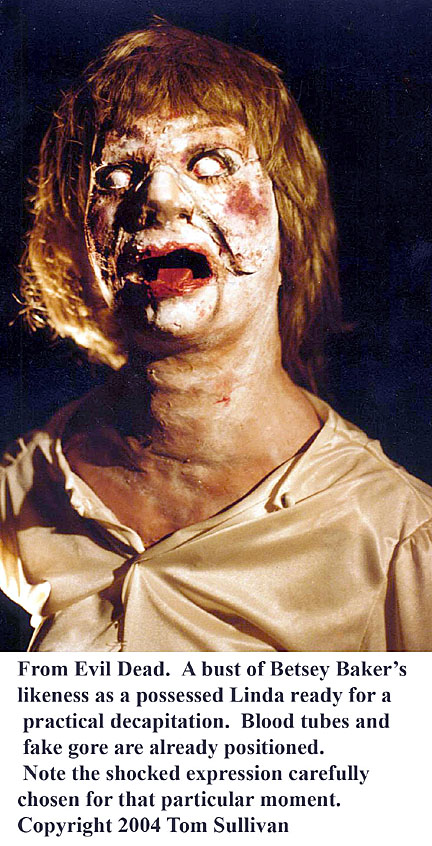
Robert: If a person want to try to tackle some of these things themselves, are there books or videos available out there that you would recommend a person studies to learn film makeup techniques?
Tom: Again a quick search on the web will yield excellent results but to mention the classics is important.
Techniques and Instruction Books
Stage Makeup by Richard Corson, Prentice Hall
The Technique of Film and Television Make-Up by Vincent J-R Kehoe, Hastings House Publishers, Inc
Dick Smith’s Do It Yourself Monster Make-Up Handbook, Imagine Inc.
Dick Smith’s course is essential for all Make up Artists!
Grande Illusions, Books 1 and 2 by Tom Savini
Morris Costumes
If Cinemagic Magazine is ever reprinted its worth it for the range of basics of make-up and special effects techniques.
History of Make-up Books
Lon of 1000 Faces by Forrest J. Ackerman, Morrison Raven-Hill Company
Making a Monster by Al Taylor and Sue Roy
Crown Publishers Inc.
There are a lot more Books and Magazines on this topic but I find these essential for your library.
Robert: With more companies getting into CGI, how do you feel that affects special effects makeup for films in general?
Tom: It’s become a cliché but CGI is another astounding tool for an apparently infinite range of effects. With that said I hear from a lot of fans and I am overwhelmed how “Old School” they are when it comes to their tastes in special effects. It’s not unusual to hear preferences for Ray Harryhausen’s work over the average Digital critters. I think Ray is amazing myself. He is a major influence in my life choices. I think with digital compositing and the video assist of new stop motion software, stop motion animation is as vital and energetic as ever. So I’m in with that Old School group.
Now that Make-up effects are commonly achieved in CGI and whole characters are being rendered in a computer it seems clear that like the good Old School effects Masters it’s those rarified group of skillful and innovative artists with sufficient capital who can make it work. We know who they are. When the smoke clears CGI will be changing everything so surrender to it, unless that clashes with your film concept.
Robert: What do you think the future holds in store for you in this profession?
Tom: As far as Make-up my days are pretty much over. I am more interested in Writing, Producing and Directing my own stories and with Digital Cameras and Software that is amazingly possible. That’s were I’m headed.
Robert: Is there anything I have not addressed that you would like to say on the subject of makeup for independent films?
Tom: It seems like we’ve seen it all in Make up effects but I doubt it. I appreciate the craft and art and science of make-up but I am looking for more sophistication than gore for gore’s sake.
Listen to me talk, what am I saying? I’m the Evil Dead blood and guts guy. It’s just that I miss good stories with hope in my movies. After all, everybody working on a film is a storyteller and sometimes I feel that idea is being lost. Learn what has gone before and advance the art. Earth needs artists!
Thank you.
Robert: Thank you Tom!
